Human Resource Management: Rater Errors and Training Interventions
VerifiedAdded on 2022/08/27
|10
|1871
|16
Report
AI Summary
This report delves into the critical area of human resource management, specifically focusing on the challenges of unbiased performance evaluation. It highlights various rater errors, including recency bias, primacy bias, halo effects, central tendency bias, leniency bias, similar-to-me bias, and gender bias, which significantly impact the accuracy of employee assessments. The study, based on a Saudi Arabian company, emphasizes the importance of aligning organizational and employee goals with the performance management system to enhance employee performance. It recommends a training intervention for performance raters, involving criteria-based evaluations and the anonymization of employee information to mitigate biases. The report also underscores the benefits of this training, such as reducing bias and ensuring that performance evaluations align with organizational objectives. In conclusion, the report stresses the need for unbiased performance evaluations to foster an optimal workforce and suggests that overcoming rater errors requires raters to develop the skill of criteria-based evaluation.
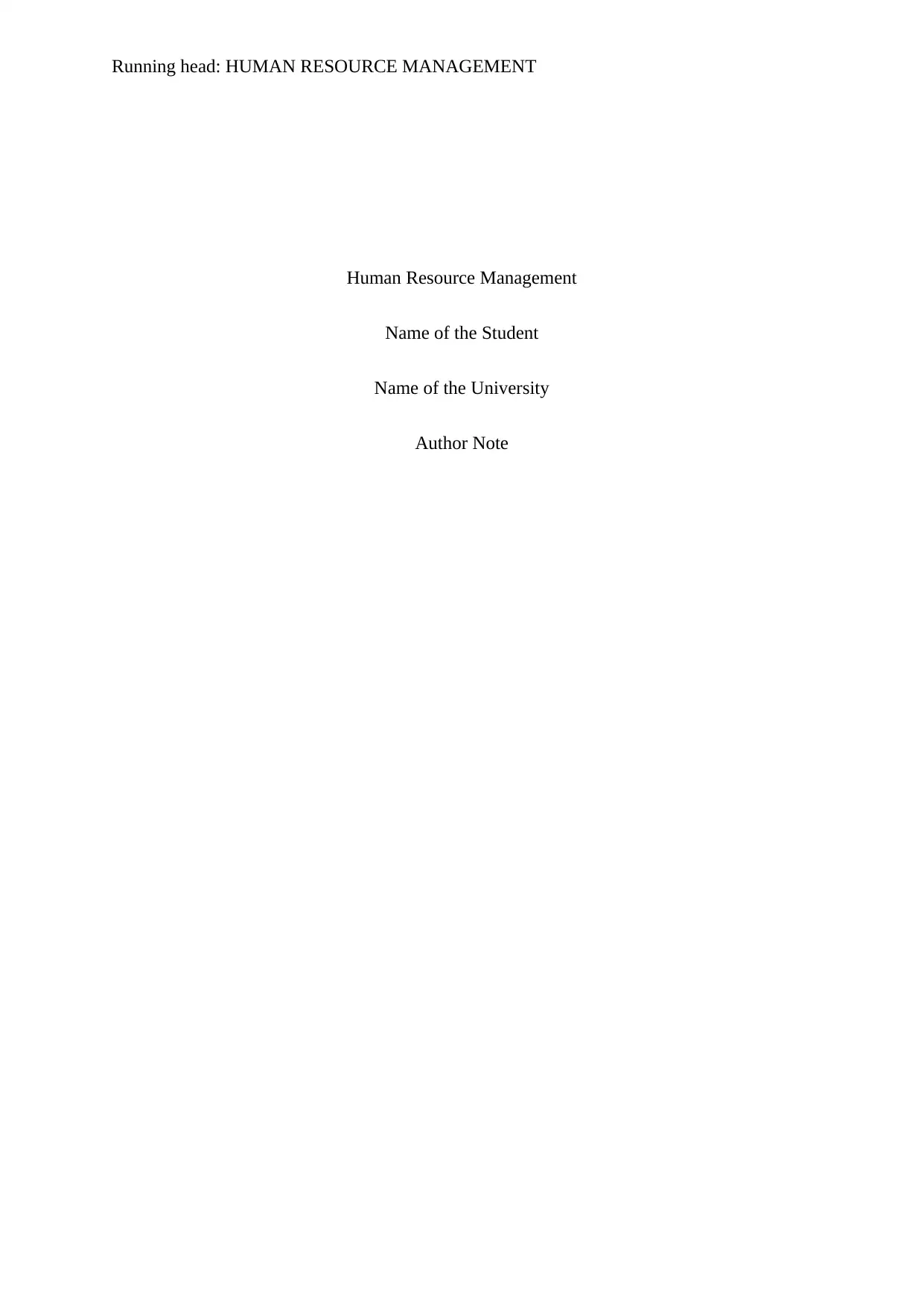
Running head: HUMAN RESOURCE MANAGEMENT
Human Resource Management
Name of the Student
Name of the University
Author Note
Human Resource Management
Name of the Student
Name of the University
Author Note
Paraphrase This Document
Need a fresh take? Get an instant paraphrase of this document with our AI Paraphraser
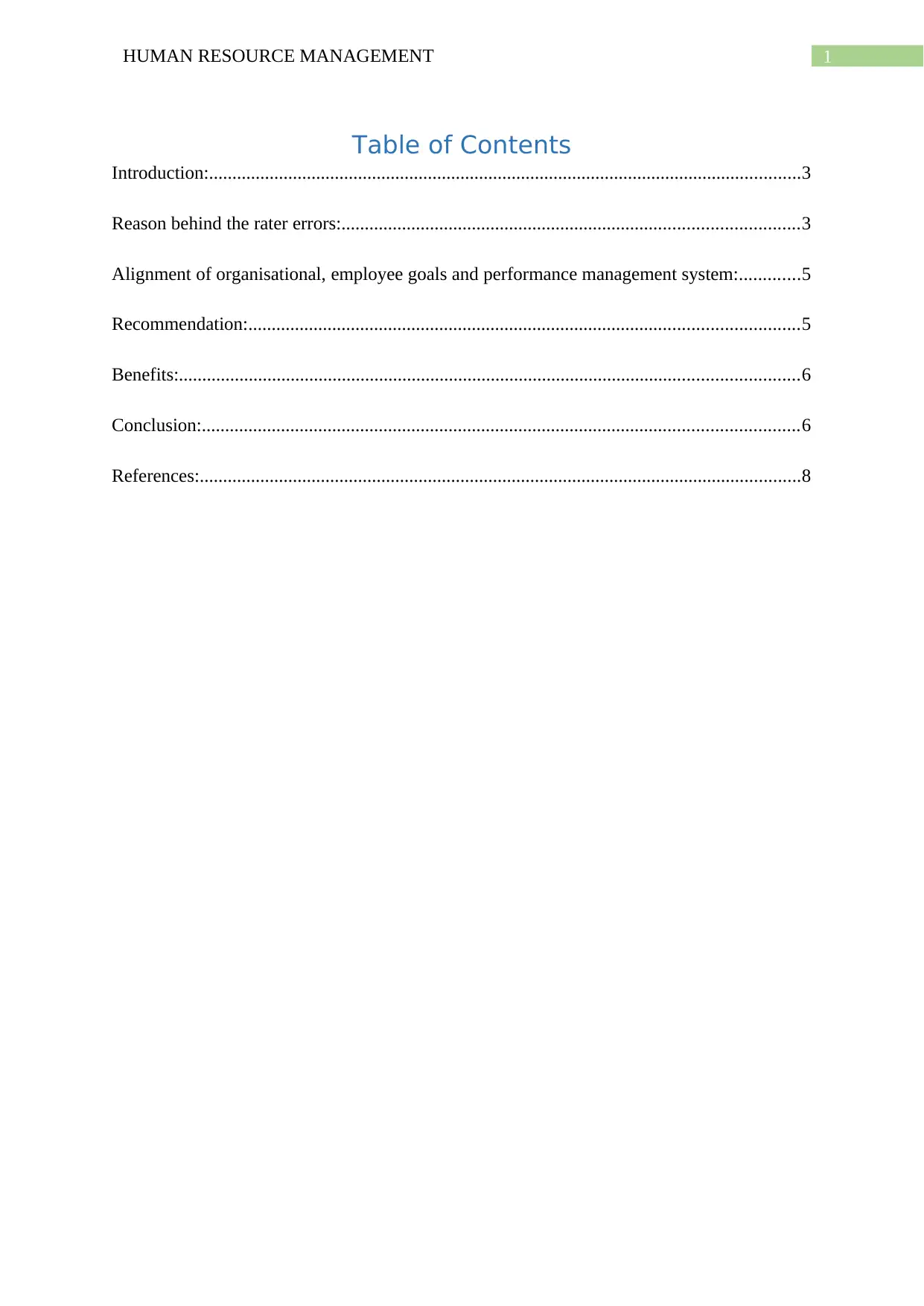
1HUMAN RESOURCE MANAGEMENT
Table of Contents
Introduction:...............................................................................................................................3
Reason behind the rater errors:..................................................................................................3
Alignment of organisational, employee goals and performance management system:.............5
Recommendation:......................................................................................................................5
Benefits:.....................................................................................................................................6
Conclusion:................................................................................................................................6
References:.................................................................................................................................8
Table of Contents
Introduction:...............................................................................................................................3
Reason behind the rater errors:..................................................................................................3
Alignment of organisational, employee goals and performance management system:.............5
Recommendation:......................................................................................................................5
Benefits:.....................................................................................................................................6
Conclusion:................................................................................................................................6
References:.................................................................................................................................8

2HUMAN RESOURCE MANAGEMENT
Introduction:
As per the esteemed opinion of Jenter and Kanaan (2015), the sustainability of an
optimal workforce is primarily reliant on the ability of the leaders in effectively motivating
the employees. According to the comments of Shields et al. (2015), the ability of the modern
business leaders in motivating the employees is dependent on the success of the employees in
evaluating the performances of the employees in an unbiased manner. The performance
management is an important human resource intervention where the performances of the
employees gets evaluated of the employees and on the basis of the same, the further
improvement feedback and rewards are delivered to the employees. The study is based on a
Saudi Arabian company. The study identifies the possible scope for the impact of the rater
bias. Along with that, the study portrays the importance between the linkage of organisational
goals, employee goals and performance system. In addition to this, the study also
recommends a suitable training intervention for the raters in performance evaluation. Other
than this, it also informs regarding the benefits of the mentioned training intervention.
Reason behind the rater errors:
There are several reasons that affect the performance evaluation of the managers in a
negative manner in the modern world of trade. One of the major concern for the raters with
the performance evaluation is the impact of the recency bias (John Bernardin et al. 2016).
The recency bias influences the raters to consider the performance or events of the employees
in recent times rather than considering the performance of the employees for the entire
duration of the performance evaluation. Other than this, Iqbal, Akbar and Budhwar (2015),
mentioned that the accuracy of the performance evaluation of the employees also gets
tremendously affected with the primacy bias. The primacy bias influences the raters to rate
the performance of an employee with a precise consideration towards primary information
Introduction:
As per the esteemed opinion of Jenter and Kanaan (2015), the sustainability of an
optimal workforce is primarily reliant on the ability of the leaders in effectively motivating
the employees. According to the comments of Shields et al. (2015), the ability of the modern
business leaders in motivating the employees is dependent on the success of the employees in
evaluating the performances of the employees in an unbiased manner. The performance
management is an important human resource intervention where the performances of the
employees gets evaluated of the employees and on the basis of the same, the further
improvement feedback and rewards are delivered to the employees. The study is based on a
Saudi Arabian company. The study identifies the possible scope for the impact of the rater
bias. Along with that, the study portrays the importance between the linkage of organisational
goals, employee goals and performance system. In addition to this, the study also
recommends a suitable training intervention for the raters in performance evaluation. Other
than this, it also informs regarding the benefits of the mentioned training intervention.
Reason behind the rater errors:
There are several reasons that affect the performance evaluation of the managers in a
negative manner in the modern world of trade. One of the major concern for the raters with
the performance evaluation is the impact of the recency bias (John Bernardin et al. 2016).
The recency bias influences the raters to consider the performance or events of the employees
in recent times rather than considering the performance of the employees for the entire
duration of the performance evaluation. Other than this, Iqbal, Akbar and Budhwar (2015),
mentioned that the accuracy of the performance evaluation of the employees also gets
tremendously affected with the primacy bias. The primacy bias influences the raters to rate
the performance of an employee with a precise consideration towards primary information
⊘ This is a preview!⊘
Do you want full access?
Subscribe today to unlock all pages.

Trusted by 1+ million students worldwide
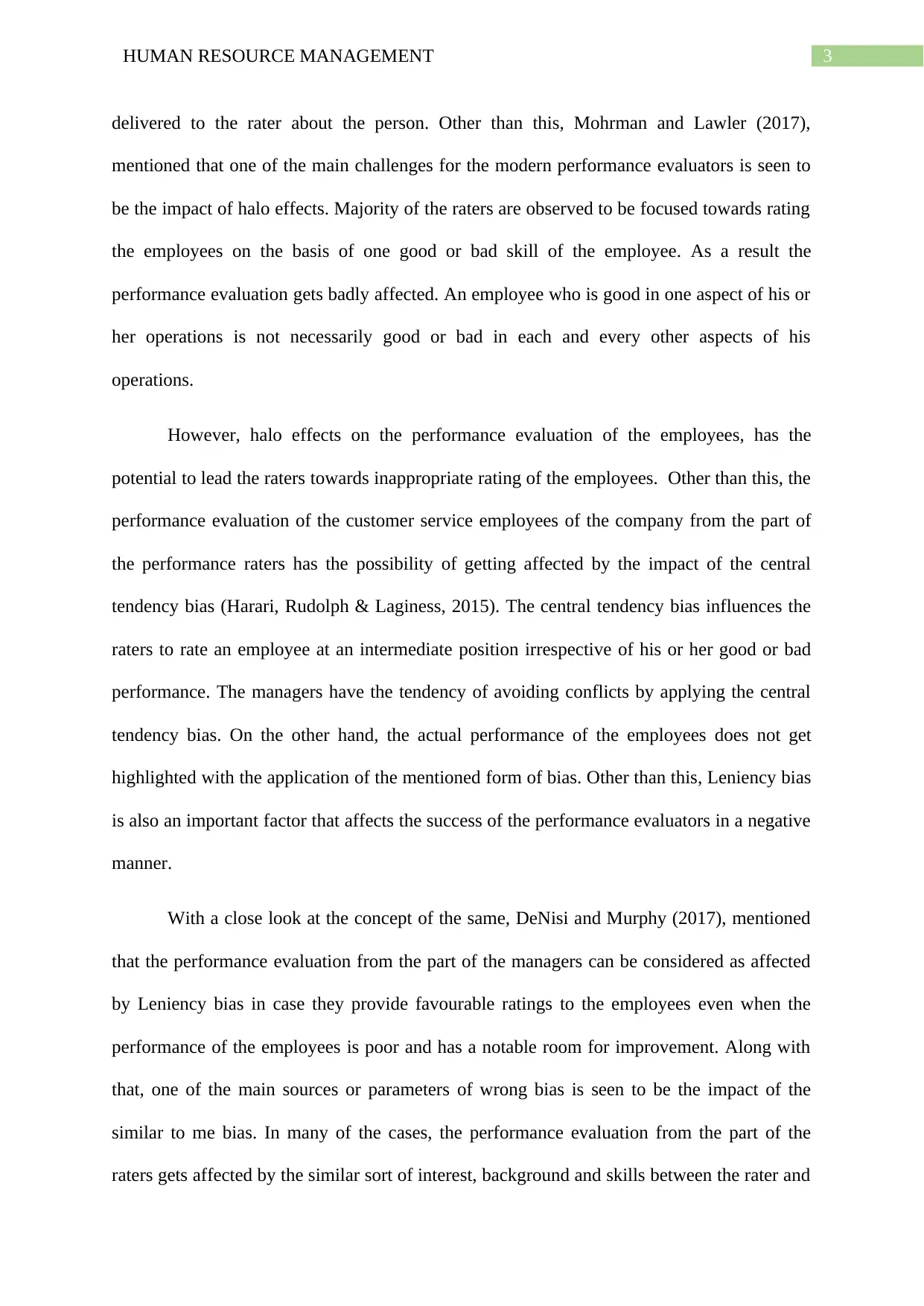
3HUMAN RESOURCE MANAGEMENT
delivered to the rater about the person. Other than this, Mohrman and Lawler (2017),
mentioned that one of the main challenges for the modern performance evaluators is seen to
be the impact of halo effects. Majority of the raters are observed to be focused towards rating
the employees on the basis of one good or bad skill of the employee. As a result the
performance evaluation gets badly affected. An employee who is good in one aspect of his or
her operations is not necessarily good or bad in each and every other aspects of his
operations.
However, halo effects on the performance evaluation of the employees, has the
potential to lead the raters towards inappropriate rating of the employees. Other than this, the
performance evaluation of the customer service employees of the company from the part of
the performance raters has the possibility of getting affected by the impact of the central
tendency bias (Harari, Rudolph & Laginess, 2015). The central tendency bias influences the
raters to rate an employee at an intermediate position irrespective of his or her good or bad
performance. The managers have the tendency of avoiding conflicts by applying the central
tendency bias. On the other hand, the actual performance of the employees does not get
highlighted with the application of the mentioned form of bias. Other than this, Leniency bias
is also an important factor that affects the success of the performance evaluators in a negative
manner.
With a close look at the concept of the same, DeNisi and Murphy (2017), mentioned
that the performance evaluation from the part of the managers can be considered as affected
by Leniency bias in case they provide favourable ratings to the employees even when the
performance of the employees is poor and has a notable room for improvement. Along with
that, one of the main sources or parameters of wrong bias is seen to be the impact of the
similar to me bias. In many of the cases, the performance evaluation from the part of the
raters gets affected by the similar sort of interest, background and skills between the rater and
delivered to the rater about the person. Other than this, Mohrman and Lawler (2017),
mentioned that one of the main challenges for the modern performance evaluators is seen to
be the impact of halo effects. Majority of the raters are observed to be focused towards rating
the employees on the basis of one good or bad skill of the employee. As a result the
performance evaluation gets badly affected. An employee who is good in one aspect of his or
her operations is not necessarily good or bad in each and every other aspects of his
operations.
However, halo effects on the performance evaluation of the employees, has the
potential to lead the raters towards inappropriate rating of the employees. Other than this, the
performance evaluation of the customer service employees of the company from the part of
the performance raters has the possibility of getting affected by the impact of the central
tendency bias (Harari, Rudolph & Laginess, 2015). The central tendency bias influences the
raters to rate an employee at an intermediate position irrespective of his or her good or bad
performance. The managers have the tendency of avoiding conflicts by applying the central
tendency bias. On the other hand, the actual performance of the employees does not get
highlighted with the application of the mentioned form of bias. Other than this, Leniency bias
is also an important factor that affects the success of the performance evaluators in a negative
manner.
With a close look at the concept of the same, DeNisi and Murphy (2017), mentioned
that the performance evaluation from the part of the managers can be considered as affected
by Leniency bias in case they provide favourable ratings to the employees even when the
performance of the employees is poor and has a notable room for improvement. Along with
that, one of the main sources or parameters of wrong bias is seen to be the impact of the
similar to me bias. In many of the cases, the performance evaluation from the part of the
raters gets affected by the similar sort of interest, background and skills between the rater and
Paraphrase This Document
Need a fresh take? Get an instant paraphrase of this document with our AI Paraphraser

4HUMAN RESOURCE MANAGEMENT
employees. The bias leads the raters towards inaccurate measurement of performance. Along
with that, one of the main concerns in the performance evaluation is seen to be the impact of
the fender bias. The gender bias has tremendous impact on the success of the raters in
assessing the performance of the employees in an appropriate manner. As per the comments
of DeNisi and Murphy (2017), the gender bias influences the raters in rating an employee of a
particular gender which the raters likes or prefers. Similarly, the employees belonging to the
less preferred gender, gets inappropriately rated.
Alignment of organisational, employee goals and performance management
system:
According to the comments of Pulakos et al. (2015), the appropriate alignment of the
employee goals with the organisational goals has the possibility of influencing the employees
in an appropriate manner when it comes to enhance their level of Performance. Bititci, Cocca
and Ates (2016), mentioned that the perfect alignment between the needs of the employees
and the rewards has the possibility of motivating the employee to increase his or her
performance. On the other hand, the alignment between the organisational goals and his or
her operational activities will ensure that the employee is contributing to the improved
management of the organisational goals. As a result, the link between organisational goals,
employee goals and the performance management system is much required for the
sustainability of the companies.
Recommendation:
The recommended training intervention for the performance raters of the organization
will be their participation in a training activity where the raters will practice the performance
rating on a 10 criteria based rating form. The rating criterion will be related to the skills
associated with the operational activities of the employees. Other than this, the criterion of
employees. The bias leads the raters towards inaccurate measurement of performance. Along
with that, one of the main concerns in the performance evaluation is seen to be the impact of
the fender bias. The gender bias has tremendous impact on the success of the raters in
assessing the performance of the employees in an appropriate manner. As per the comments
of DeNisi and Murphy (2017), the gender bias influences the raters in rating an employee of a
particular gender which the raters likes or prefers. Similarly, the employees belonging to the
less preferred gender, gets inappropriately rated.
Alignment of organisational, employee goals and performance management
system:
According to the comments of Pulakos et al. (2015), the appropriate alignment of the
employee goals with the organisational goals has the possibility of influencing the employees
in an appropriate manner when it comes to enhance their level of Performance. Bititci, Cocca
and Ates (2016), mentioned that the perfect alignment between the needs of the employees
and the rewards has the possibility of motivating the employee to increase his or her
performance. On the other hand, the alignment between the organisational goals and his or
her operational activities will ensure that the employee is contributing to the improved
management of the organisational goals. As a result, the link between organisational goals,
employee goals and the performance management system is much required for the
sustainability of the companies.
Recommendation:
The recommended training intervention for the performance raters of the organization
will be their participation in a training activity where the raters will practice the performance
rating on a 10 criteria based rating form. The rating criterion will be related to the skills
associated with the operational activities of the employees. Other than this, the criterion of

5HUMAN RESOURCE MANAGEMENT
the performance evaluation is in need to be perfectly aligned with the organisational goals of
the company. In addition to this, the raters will be asked to practice their evaluation on certain
rating forms where the information regarding the employees and demographics will be
hidden. Along with that, the performance raters will be asked to provide mandatory feedback
for each and every performance rating.
Benefits:
With a close look at the recommended training intervention, it is understandable that
the training will be crucial in ensuring that the performance raters do not get any sort of
information regarding the employees whom they are rating. As a result, this will ensure that
the impact of the primacy bias and similar to me bias will be tackled in a professional
manner. Other than this, the practice of the criteria based evaluation will also be important in
ensuring that the performance raters have the ability to avoid recency bias, halo bias, central
tendency along with Leniency bias in an efficient manner (Harari, Rudolph & Laginess,
2015). Other than this, the alignment of the appropriate strategic measurement method and
the organizational goals ensures that the performance of the employees which gets recognised
and assessed through the measurement method is perfectly aligned with the objectives of the
organization. With this alignment, the organization ensures that they value the service of the
employees which is linked with the goals of the organization.
Conclusion:
On a concluding note, it is visible that the unbiased performance evaluation is
significantly important for the development of an optimal workforce in the organizations
operating in the modern world of trade. Having said that, the performance evaluation of the
raters gets badly affected with the rater bias such as halo effects, Leniency effect, central
tendency effects, similar to me bias and primacy error. The ability of the employees in
the performance evaluation is in need to be perfectly aligned with the organisational goals of
the company. In addition to this, the raters will be asked to practice their evaluation on certain
rating forms where the information regarding the employees and demographics will be
hidden. Along with that, the performance raters will be asked to provide mandatory feedback
for each and every performance rating.
Benefits:
With a close look at the recommended training intervention, it is understandable that
the training will be crucial in ensuring that the performance raters do not get any sort of
information regarding the employees whom they are rating. As a result, this will ensure that
the impact of the primacy bias and similar to me bias will be tackled in a professional
manner. Other than this, the practice of the criteria based evaluation will also be important in
ensuring that the performance raters have the ability to avoid recency bias, halo bias, central
tendency along with Leniency bias in an efficient manner (Harari, Rudolph & Laginess,
2015). Other than this, the alignment of the appropriate strategic measurement method and
the organizational goals ensures that the performance of the employees which gets recognised
and assessed through the measurement method is perfectly aligned with the objectives of the
organization. With this alignment, the organization ensures that they value the service of the
employees which is linked with the goals of the organization.
Conclusion:
On a concluding note, it is visible that the unbiased performance evaluation is
significantly important for the development of an optimal workforce in the organizations
operating in the modern world of trade. Having said that, the performance evaluation of the
raters gets badly affected with the rater bias such as halo effects, Leniency effect, central
tendency effects, similar to me bias and primacy error. The ability of the employees in
⊘ This is a preview!⊘
Do you want full access?
Subscribe today to unlock all pages.

Trusted by 1+ million students worldwide
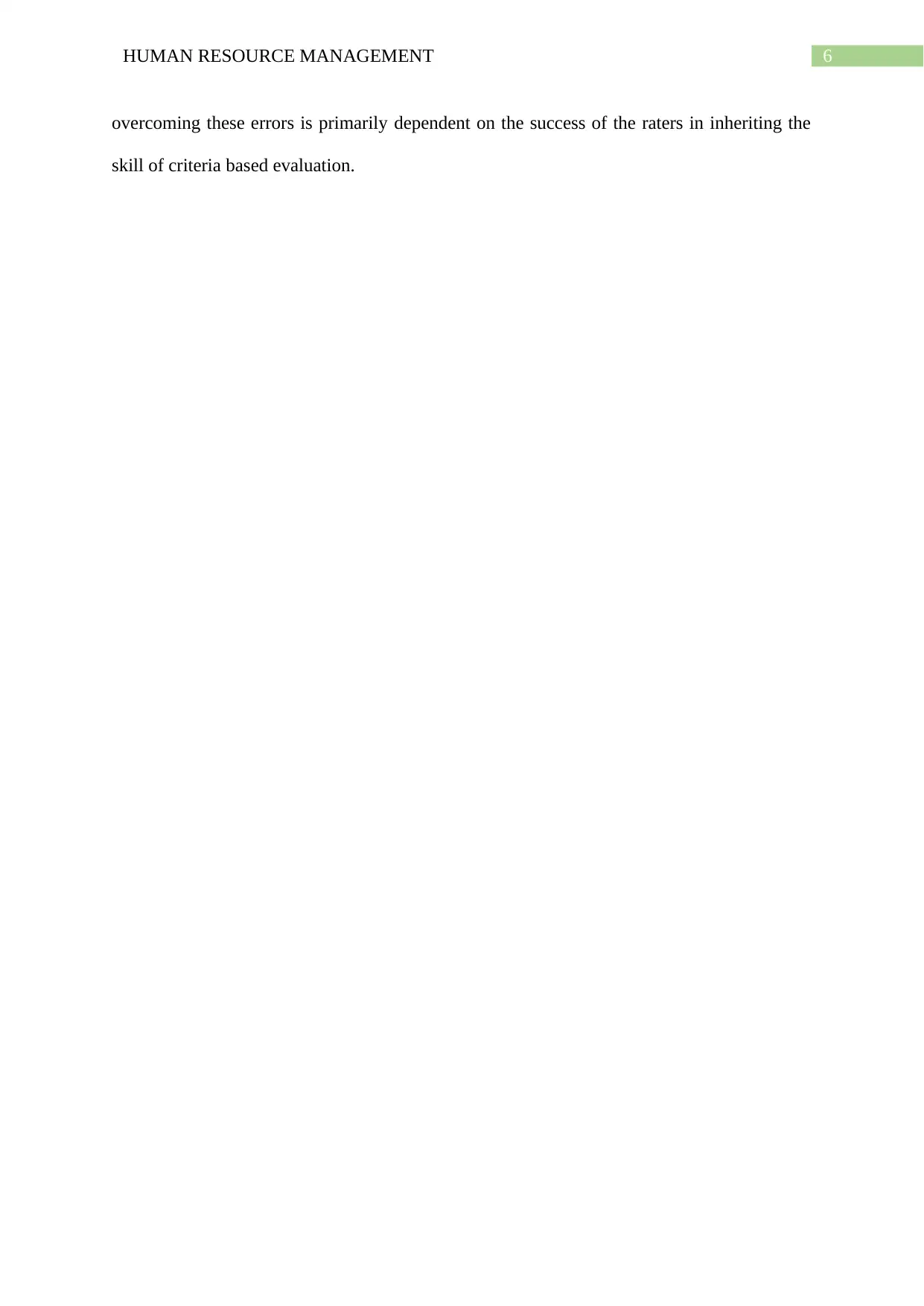
6HUMAN RESOURCE MANAGEMENT
overcoming these errors is primarily dependent on the success of the raters in inheriting the
skill of criteria based evaluation.
overcoming these errors is primarily dependent on the success of the raters in inheriting the
skill of criteria based evaluation.
Paraphrase This Document
Need a fresh take? Get an instant paraphrase of this document with our AI Paraphraser

7HUMAN RESOURCE MANAGEMENT
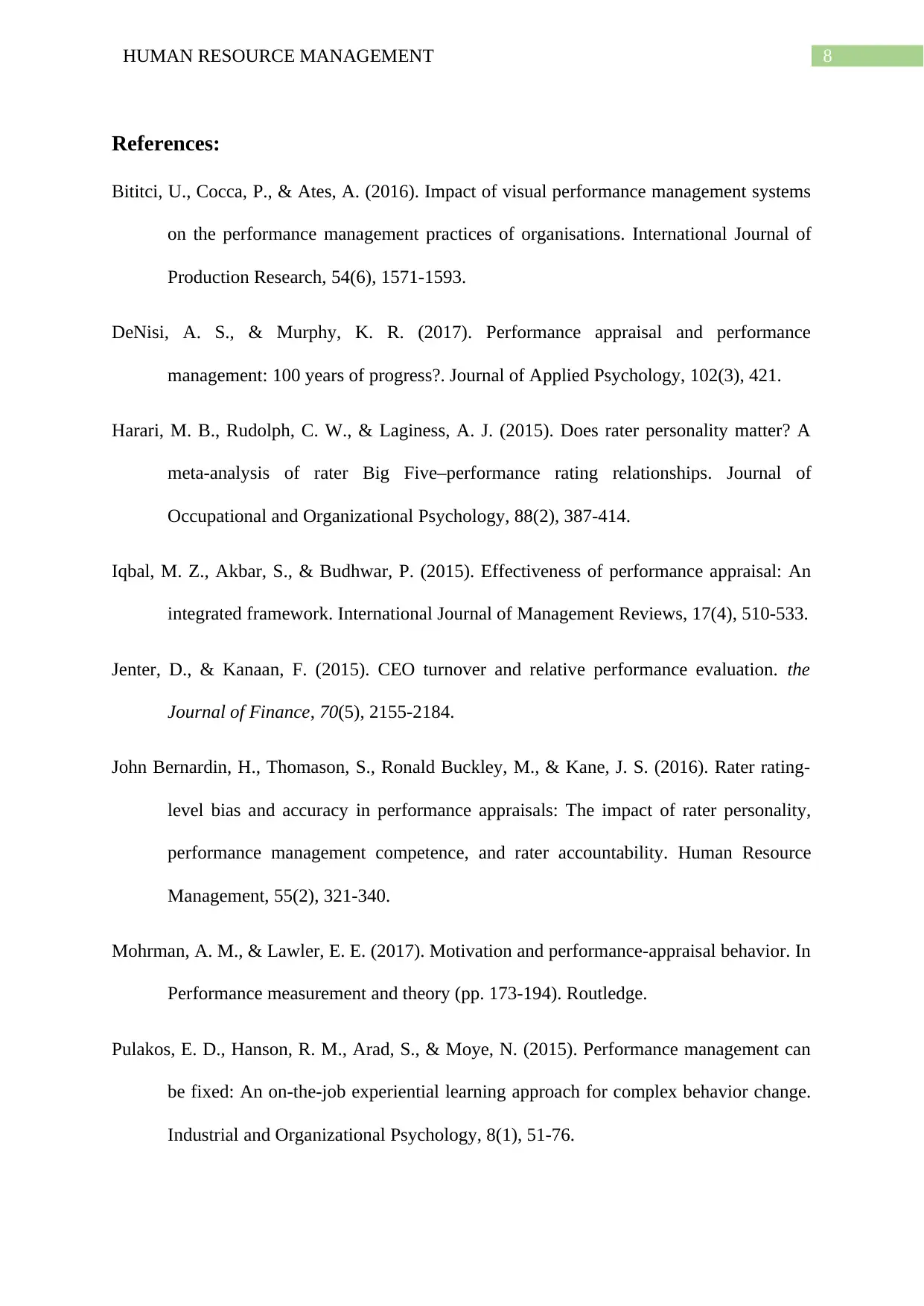
8HUMAN RESOURCE MANAGEMENT
References:
Bititci, U., Cocca, P., & Ates, A. (2016). Impact of visual performance management systems
on the performance management practices of organisations. International Journal of
Production Research, 54(6), 1571-1593.
DeNisi, A. S., & Murphy, K. R. (2017). Performance appraisal and performance
management: 100 years of progress?. Journal of Applied Psychology, 102(3), 421.
Harari, M. B., Rudolph, C. W., & Laginess, A. J. (2015). Does rater personality matter? A
meta‐analysis of rater Big Five–performance rating relationships. Journal of
Occupational and Organizational Psychology, 88(2), 387-414.
Iqbal, M. Z., Akbar, S., & Budhwar, P. (2015). Effectiveness of performance appraisal: An
integrated framework. International Journal of Management Reviews, 17(4), 510-533.
Jenter, D., & Kanaan, F. (2015). CEO turnover and relative performance evaluation. the
Journal of Finance, 70(5), 2155-2184.
John Bernardin, H., Thomason, S., Ronald Buckley, M., & Kane, J. S. (2016). Rater rating‐
level bias and accuracy in performance appraisals: The impact of rater personality,
performance management competence, and rater accountability. Human Resource
Management, 55(2), 321-340.
Mohrman, A. M., & Lawler, E. E. (2017). Motivation and performance-appraisal behavior. In
Performance measurement and theory (pp. 173-194). Routledge.
Pulakos, E. D., Hanson, R. M., Arad, S., & Moye, N. (2015). Performance management can
be fixed: An on-the-job experiential learning approach for complex behavior change.
Industrial and Organizational Psychology, 8(1), 51-76.
References:
Bititci, U., Cocca, P., & Ates, A. (2016). Impact of visual performance management systems
on the performance management practices of organisations. International Journal of
Production Research, 54(6), 1571-1593.
DeNisi, A. S., & Murphy, K. R. (2017). Performance appraisal and performance
management: 100 years of progress?. Journal of Applied Psychology, 102(3), 421.
Harari, M. B., Rudolph, C. W., & Laginess, A. J. (2015). Does rater personality matter? A
meta‐analysis of rater Big Five–performance rating relationships. Journal of
Occupational and Organizational Psychology, 88(2), 387-414.
Iqbal, M. Z., Akbar, S., & Budhwar, P. (2015). Effectiveness of performance appraisal: An
integrated framework. International Journal of Management Reviews, 17(4), 510-533.
Jenter, D., & Kanaan, F. (2015). CEO turnover and relative performance evaluation. the
Journal of Finance, 70(5), 2155-2184.
John Bernardin, H., Thomason, S., Ronald Buckley, M., & Kane, J. S. (2016). Rater rating‐
level bias and accuracy in performance appraisals: The impact of rater personality,
performance management competence, and rater accountability. Human Resource
Management, 55(2), 321-340.
Mohrman, A. M., & Lawler, E. E. (2017). Motivation and performance-appraisal behavior. In
Performance measurement and theory (pp. 173-194). Routledge.
Pulakos, E. D., Hanson, R. M., Arad, S., & Moye, N. (2015). Performance management can
be fixed: An on-the-job experiential learning approach for complex behavior change.
Industrial and Organizational Psychology, 8(1), 51-76.
⊘ This is a preview!⊘
Do you want full access?
Subscribe today to unlock all pages.

Trusted by 1+ million students worldwide
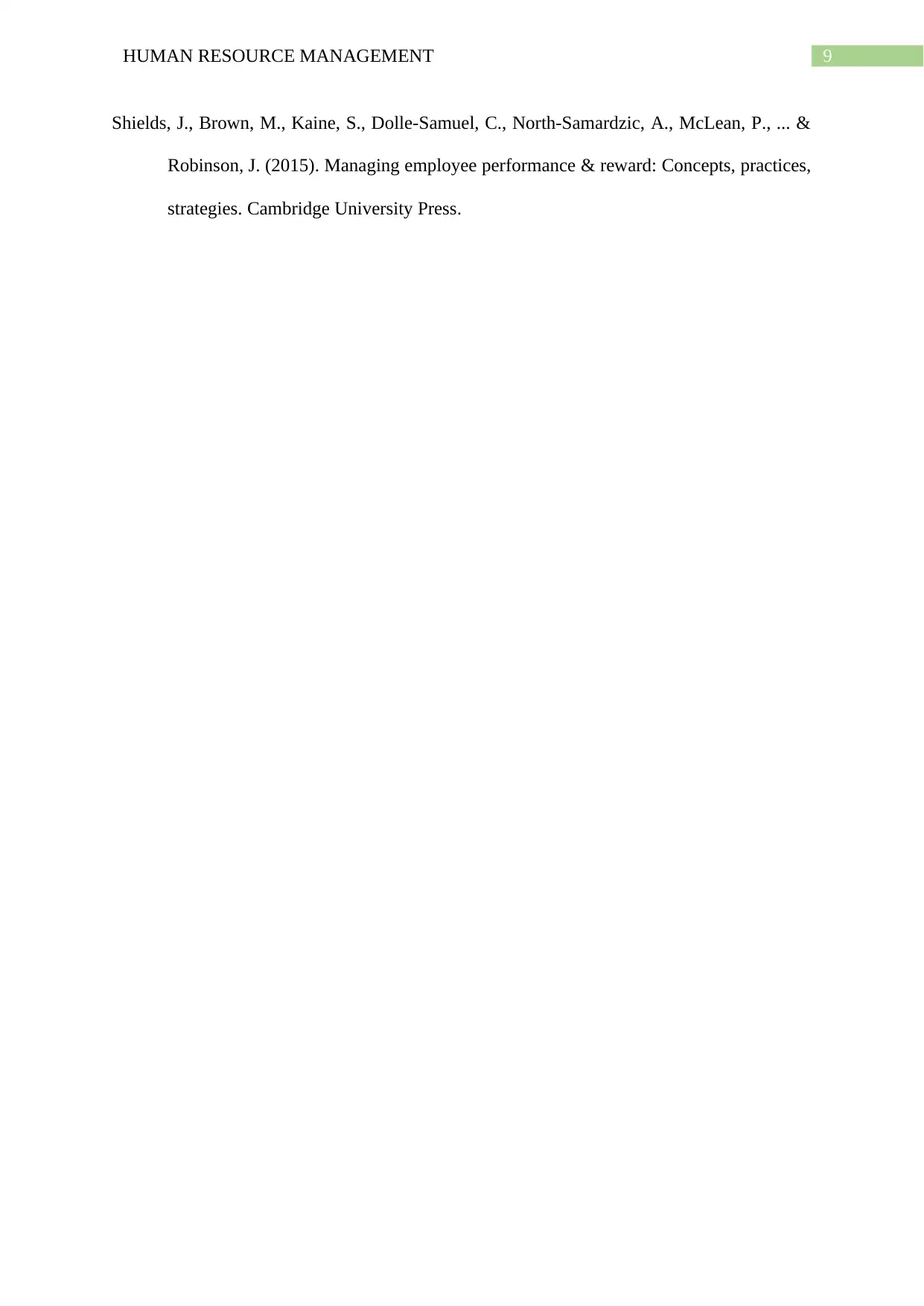
9HUMAN RESOURCE MANAGEMENT
Shields, J., Brown, M., Kaine, S., Dolle-Samuel, C., North-Samardzic, A., McLean, P., ... &
Robinson, J. (2015). Managing employee performance & reward: Concepts, practices,
strategies. Cambridge University Press.
Shields, J., Brown, M., Kaine, S., Dolle-Samuel, C., North-Samardzic, A., McLean, P., ... &
Robinson, J. (2015). Managing employee performance & reward: Concepts, practices,
strategies. Cambridge University Press.
1 out of 10
Related Documents
Your All-in-One AI-Powered Toolkit for Academic Success.
+13062052269
info@desklib.com
Available 24*7 on WhatsApp / Email
![[object Object]](/_next/static/media/star-bottom.7253800d.svg)
Unlock your academic potential
Copyright © 2020–2025 A2Z Services. All Rights Reserved. Developed and managed by ZUCOL.





